The Fall of the Rule of Law in South Korea: The Impeachment of Park Geun-Hye, Part I: The Media, the Tablet, Public Sentiment, Gookjeong Nongdan, and the National Assembly
2019-7-12, Tara O
- Timeline of the Impeachment and related events
- Impeached for “Gookjeong Nongdan”–terminology explained
- JTBC’s Tablet Story
- Candlelight Protests/Public Sentiment
- The South Korean Constitution on impeachment and the duty of the President
- National Assembly: Impeached after only six days
It has been over two years since South Korean president Park Geun-hye was impeached, yet most people do not know exactly what happened or how enormously negative of an impact the impeachment had on the rule of law in South Korea. Most people assume that the process of impeachment was fair and according to the Constitution and laws. After all, it appeared that the separation of power among the three branches of the government seemed to have worked–the legislative and judiciary branches checking and balancing the executive branch. It seems the National Assembly voted on the impeachment resolution, and it was referred to the Constitutional Court, and the Constitutional Court made a decision to “dismiss” her 8:0. The western press mentioned bribery and corruption. It appeared there was a massive investigation on the impeachment case. The key assumption is that there must have been evidence that found her guilty of various charges, and that they were worthy of impeachment and jailing. After all, South Korea is an advanced democracy and wealthy, is it not? Also, the media reported it that way, and people held candlelights. Yet, how many people, South Koreans and foreigners, really know exactly what happened? What was she really charged with? How long did it take for the National Assembly to vote on the impeachment bill? Did everyone support her impeachment? What was the evidence? Was there really an investigation? Was the legal process fair and according to the law?
The purpose of this paper is not to discuss the entire impeachment case, but to introduce a portion of the impeachment to start the process of revealing truth. This portion (Part I) focuses on what the main impetus for impeachment was and how the impeachment process unfolded at the National Assembly. The point is to show how rushed, shoddy, and purposeful the process was and to raise the following questions: If they can do this to a democratically elected president, then what can they do to an average citizen? What does it mean for the rule of law, and by extension, liberal democracy in South Korea?
Timeline
- 2014-4-16: The Sewol Ferry sinks
- 2016-10-24/25/26: JTBC airs the “Tablet PC” story
- 2016-10-26: The first Candlelight Protest calling for President Park Geun-hye to step down begins (about 10 subsequent protests follow) (also called for THAAD withdrawal, free Lee Seok-ki who was jailed for sedition, abolish the National Intelligence Service)
- 2016-11-17: The investigation on Choi Seo-won (aka Choi Soon-sil) and others re: “Gookjeong Nongdan” (국정농단) begins
- 2016-11-20: The trial of Choi Seo-won (Choi Soon-sil) begins (only 3 days after the investigation on Choi began; the judge reached a decision 450 days later on February 13, 2018)
- 2016-11-28: The Democratic Party of Korea (Deobureo Minjoo Party) hosts an “emergency debate to create a bill to impeach President Park Geun-hye”
- 2016-12-3: The National Assembly introduces a bill calling for the impeachment of President Park Geun-hye. (No investigation was conducted before introducing the bill)
- 2016-12-6: The first National Assembly hearing on the state affairs investigation is scheduled. (Scheduled before the impeachment resolution was introduced, so the hearing never occurred.)
- 2016-12-9: The National Assembly votes and passes the bill to impeach President Park Geun-hye. (only 6 days after the introduction of the resolution to impeach)
- 2016-12-9: The first flag rally (or Taegukki rally) opposing the impeachment, supporting the South Korea-U.S. alliance, begins (held every Saturday since; recently it has been calling for Moon Jae-in to step down)
- 2016-12-9: The Impeachment Resolution is submitted to the Constitutional Court
- 2016-12-9: President Park Geun-hye’s official duty stops; Hwang Kyo-ahn becomes the acting president
- 2017-3-10: The Constitutional Court votes 8:0 to “dismiss” the president (92 days after impeachment)
U.S. President Nixon’s case of near impeachment timeline (for comparison):
- 1972-6-12: Watergate incident news story breaks
- 1973-2-7: The Senate establishes a Select Committee to investigate the Watergate scandal (the investigation lasts 1 year)
- 1974-2-6: The House of Representatives passes a resolution giving the Judiciary Committee the authority to investigate to see whether there are sufficient grounds for impeachment (investigation lasts about 6 months)
- 1974-7-27/29/30: The Judiciary Committee votes on each impeachable offense on different dates; Out of 5 articles of impeachment, they approve 3, and submit the 3 impeachment articles to the House of Representatives.
- 1974-8-9: Nixon resigned
Gookjeong Nongdan (국정농단): An invented term
If one asks an average Korean why President Park Geun-hye was impeached, they will likely say “gookjeong nongdan” (국정농단). What does it mean? The electronic dictionary shows that “gookjeong” means the “affairs of the state” or “government administration” and “nongdan” as “monopoly,” “monopolize,” or “the assumption of an exclusive right.” Thus it literally means monopolizing the state affairs–eerily similar to having absolute power. Was the call for impeachment of Park Geun-hye because she had an absolute power as the president? The public anger was that her friend Choi was running the country, not her. The narrative was that Park was a puppet of someone else. How can one have an absolute power and be thoroughly controlled at the same time? Thus, the term Googkjeong nongdan, as explained in the dictionary, does not match what many people believe it is–that Choi Seo-won, President Park Geun-hye’s friend, involved herself in and ran the state affairs.
The term “gookjeong nongdan” became ubiquitous in 2016.(1) Most people did not know what it meant (and many still do not). While “gookjeong” has been known and used, “nongdan” has not been used much, because “nongdan” is an ancient term that was used hundreds of years ago, but not much in modern days.(2) This is why the term “nongdan” did not appear in paper dictionaries, but appeared in only electronic dictionaries, which are easily updated. According to Pyong-woo Kim, who has taught the History of Chosun Dynasty Law, while gookjeong nongdan was not illegal, it was a term used in the Chosun Dynasty during the “Strife among the Four Factions” to annihilate the other parties/factions.(3)
OhMyNews admitted it is a term unknown to modern Koreans and described “nongdan” as an ancient term that means a “high hill” and states that it means doing what one wants. It is unclear how a high hill translates to “doing what one wants,” but what is clear is that it is a confusing and unknown term. There are other ways to express involvement in state affairs using modern terminology, such as gookjeong gaeip or goodkjeong gwanyeo, but the term “gookjeong nongdan” emerged all of a sudden, and it became ubiquitous in South Korea leading up to and after the impeachment.
JTBC’s “Tablet PC” Story
Despite the esoteric and obscure nature of the term, the media began to use the “Gookjeong Nondan” widely to describe the charge that Choi Seo-won, not Park Geun-hye, was running the country by intervening in state affairs, especially after cable TV’s JTBC aired the “tablet PC” story consecutively on October 24, 25, and 26, 2016. On the 26th, JTBC’s president and anchor Sohn Suk-hee appeared himself on TV to make unfounded claims about the “tablet PC.” JTBC showed a tablet with files on the screen and said that Choi edits Park Geun-hye’s speeches and reviews government documents. (0:44) Other media outlets picked up the story, and the tablet story spread like wildfire.
JTBC claimed on October 19, 2016 and again on October 26 that Choi likes to walk around with the tablet and fix Park’s speeches, implying that since Choi edits Park’s speech, Choi runs the country, instead of Park. This leap in conclusion defies logic, since presidents can get advice from various people, and getting advice does not mean the adviser, formal or informal, runs the country. Additionally, there is no evidence that Choi used the tablet to edit Park’s speech or that the tablet even belongs to Choi.
This claim, however, led people to believe that Park was not running the country–“gookjeong nongdan.” JTBC’s unsubstantiated claim about the tablet PC embarrassed and angered the public, leading to multiple, large-scale candlelight protests. The National Assembly, the prosecution, and the Constitutional Court also referred to the news stories about the tablet PC as “evidence” of “gookjeong nongdan.” JTBC, popular among youths, has made other claims, such as the false story about the Sewol Ferry sinking and the Theater High Altitude Air Defense (THAAD), which were followed by protests.
JTBC’s claims about the tablet have not been verified. In fact, the government’s forensic report indicates thousands of files were created, edited, and deleted in the tablet after JTBC found the tablet. The forensic report also showed that there were multiple users of the tablet, so it could not determine to whom the tablet belonged. The forensic report did not surface until it was too late–a year later, which is a long time after Park was already impeached. Some continued to question the validity of JTBC and Sohn Suk-hee’s claims about the tablet, and the loudest were put in jail–journalists Byun Hee-jai, and later Hwang Ui-won, Byun’s journalist colleague at the same small media outlet called MediaWatch. Despite what the forensic report shows, the prosecutor for Byun Hee-jai maintains that the tablet belongs to Choi, and the judges have refused, thus far, to grant Byun’s request for further discovery of the truths behind the tablet–a violation of the principle of self-defense. Many people do not even know that the tablet was not the “smoking gun” evidence for the impeachment that JTBC claimed it was. In fact, the court never even admitted the tablet as evidence for either Park Geun-hye’s impeachment trial or the criminal trials that followed.
“Gookjeong nongdan,” a new (but old) term that sounded sophisticated, became a convenient title to describe a myriad of complex issues, allegations, rumors, and shocking stories related to Park Geun-hye and the impeachment. People became exceptionally upset at the rumor that a mere woman, someone called “Soon-sil,” which sounded like an uncouth, uneducated person, and even a “shaman” some called her, was in control of state affairs. The “Dirty Dream” painting depicts these various fabrications. National Assemblyman Pyo Chang-won, the Democratic Party of Korea (Deobureo Minjoo Party) even sponsored an “art” exhibit at the National Assembly on January 24, 2017, displaying “Dirty Dream” painting, with Park Geun-hye sleeping, with a miniature missile (meant to be THAAD) on the bed, Sewol Ferry sinking in the background, and Choi Seo-won with a bouquet of syringes with drugs.
Impeachment/Candlelight Protests
Galvanized by the “Tablet PC” story, they joined the very well-organized candlelight protests, which initially demanded that Park step down, but later that Park be impeached. Little known to them was how well these candlelight protests were organized and how many organizations, such as the violent and anti-U.S., pro-North Korea Korean Confederation of Trade Unions (KCTU) and the Teachers and Education Workers’ Union, were responsible for organizing these candlelight events that were crafted to give a festive atmosphere, complete with concerts, to be more appealing to the crowd. KCTU, one of the key organizers, often protests on various political matters, such as the Sewol Ferry sinking, in addition to the candlelight protests calling to oust Park. Numerous other unrelated demands were made at these candlelight protests, such as the demand to withdraw THAAD (Terminal High-Altitude Area Defense) and to free Lee Seok-ki, who went to jail for sedition. There were also assertions that China was maneuvering by surreptitiously sending Chinese students in South Korea to participate in the candlelight protests.
The following photos are from various candlelight protests calling for stepping down or the impeachment of Park Guen-hye.

There were even propaganda leaflets all over Seoul in late 2016/early 2017 that portrayed Park Geun-hye as a puppet of the U.S., pro-Japan, and anti-North Korea, along with anti-THAAD and anti-U.S. leaflets.
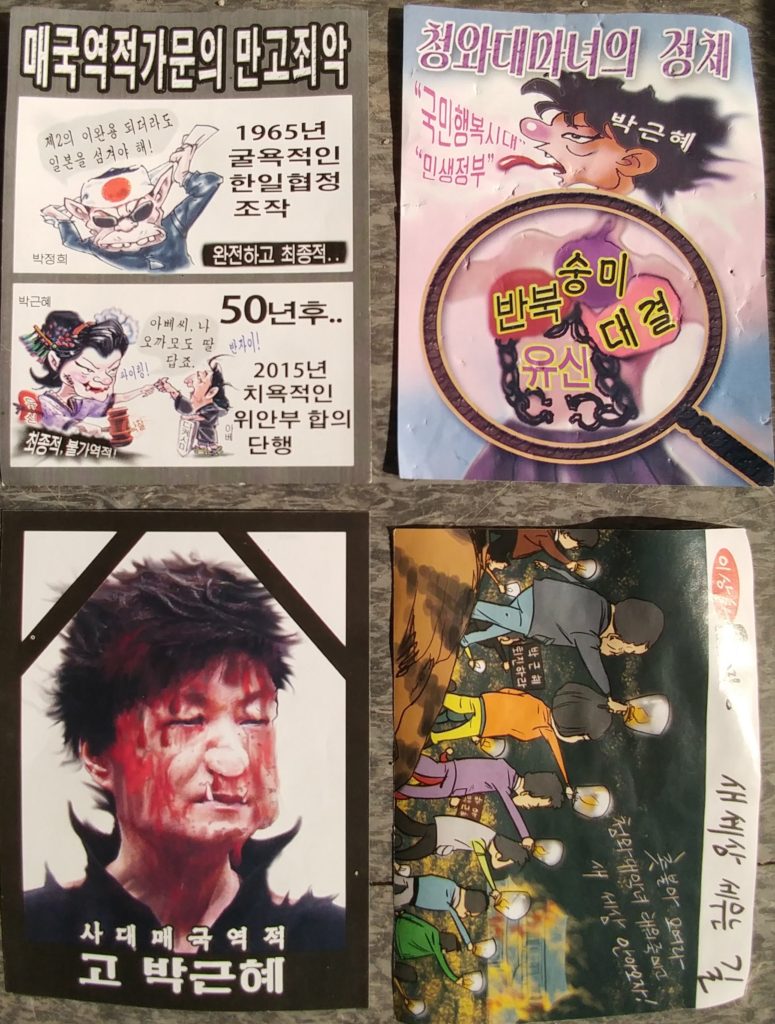
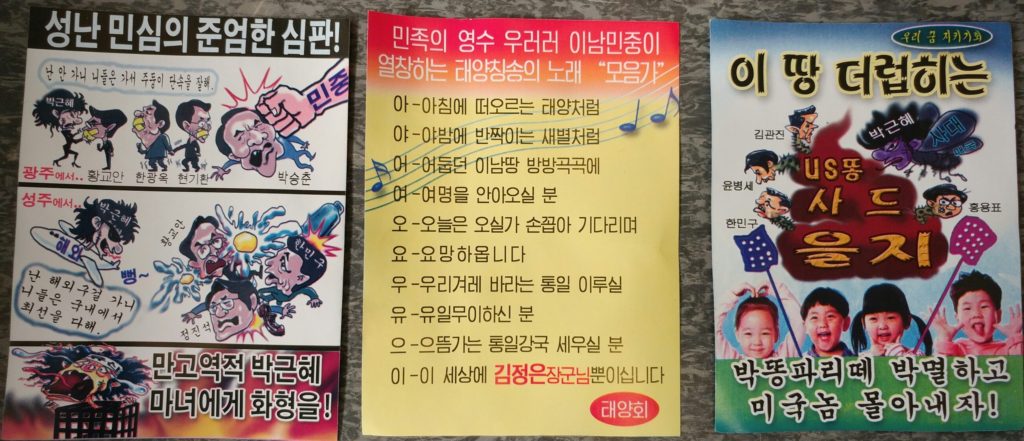
See here for a video of an amalgamation of the impeachment protests, which were not as peaceful as they claim to be, followed by the flag rallies (those who opposed the impeachment) about half way through the video.
There were also anti-impeachment rallies called Taegukki (South Korean flag) rallies, where both the South Korean and U.S. flags were seen. The first anti-impeachment rally began on November 6, 2016 by a Christian organization in front of Seoul Station, but the full scale flag rally began in central Seoul on December 9, 2016, when the National Assembly voted to impeach Park Guen-hye. The flag rallies continued every Saturday (and on important dates) thereafter. The major media often ignored the flag rallies or stated they were small, while giving extensive coverage to the candlelight protests and overestimating their size. For instance, on December 31, 2016, a candlelight protest was held at the Gwanghwamun Plaza (at the top of the photo below) while a flag rally was held near City Hall (lower part of the photo). Yonhap News reported 720,000 for the candlelight protest and only 12,000 for the flag rally, although it appears the size of the flag protest was bigger than the size of the candlelight protests. Such biased reporting gave the impression that the majority of South Koreans supported impeachment.
“Gookjeong nongdan” is not illegal. There is no such word found anywhere in the Constitution or legal codes that state that it is illegal, much less impeachable.(4) This is one of numerous problems with Park Geun-hye’s impeachment. Her impeachment was not about unconstitutionality or illegality on her part, but about carefully orchestrated emotions. The impeachment was rushed and the Constitution and other laws were ignored throughout the hasty process.
The Constitution of the Republic of Korea (ROK) on Impeachment
The Constitution’s Section 65 deals with impeachment and Section 66 describes the president’s responsibilities..
Section 65 of the ROK Constitution pertains to impeachment:
Paragraph ① The National Assembly can vote on the Motion of Impeachment when the President, Prime Minister, Cabinet Member, the Chief of each Administrative Branch, the Constitutional Court Judge, Judge, Central Election Commissioner, Auditor General, Auditor, or such public servants as determined by law violates the Constitution or the law while carrying out the duties of the office.
제65조 ①대통령·국무총리·국무위원·행정각부의 장·헌법재판소 재판관·법관·중앙선거관리위원회 위원·감사원장·감사위원 기타 법률이 정한 공무원이 그 직무집행에 있어서 헌법이나 법률을 위배한 때에는 국회는 탄핵의 소추를 의결할 수 있다.
Paragraph ② The impeachment proceedings referred to in Paragraph 1 shall be initiated by 1/3 of the members of the National Assembly, and the majority of members of the National Assembly needs to be in favor of the decision, except in the case of impeachment against the president must have a majority of the members of the National Assembly to put forth the impeachment resolution and a 2/3 majority of the members of the National Assembly voting for the impeachment bill.
②제1항의 탄핵소추는 국회재적의원 3분의 1 이상의 발의가 있어야 하며, 그 의결은 국회재적의원 과반수의 찬성이 있어야 한다. 다만, 대통령에 대한 탄핵소추는 국회재적의원 과반수의 발의와 국회재적의원 3분의 2 이상의 찬성이 있어야 한다.
Section 66 of the ROK Constitution describes the president’s duties:
- ① The president is the Head of State, and represents the state vis-a-vis foreign countries.
- ② The President has the responsibility to preserve the state’s independence and territorial integrity, the state’s continuity, and the Constitution.
- ③ The President has a sincere obligation for the peaceful reunification of the motherland.
- ④ The president is the head of executive power, and it is part of the government.
제66조
- ①대통령은 국가의 원수이며, 외국에 대하여 국가를 대표한다.
- ②대통령은 국가의 독립·영토의 보전·국가의 계속성과 헌법을 수호할 책무를 진다.
- ③대통령은 조국의 평화적 통일을 위한 성실한 의무를 진다.
- ④행정권은 대통령을 수반으로 하는 정부에 속한다.
Impeachment in only 6 days
The National Assembly impeached the nation’s president, Park Geun-hye, in a rush. There was no hearing, no investigation, and the voting occurred only six days after the introduction of the impeachment bill. This rushed and unreasonable, if not unconstitutional, impeachment process differs from the U.S. President Richard Nixon case, in which there existed two separate investigations totaling 1 year and 6 months.
The National Assembly originally scheduled a hearing regarding the impeachment situation on December 6, 2016, but three days before the scheduled hearing, opposition members of the National Assembly introduced a bill of impeachment. Thus, even before having a hearing to discuss the case, the impeachment bill was already introduced.
The impeachment bill was introduced on December 3, 2016 (Saturday), and it was voted on only six days later on December 9, 2016 (Friday). 171 lawmakers partook in tabling the bill: Democratic Party of Korea (Deobureo Minjoo Party) (all 121), People’s Party (all 38), Justice Party (6), and unaffiliated (6).(5) There was not enough time between the time of introduction of the bill and the voting of it. Apparently, most lawmakers did not even read the impeachment bill before they voted.(6) There essentially was no deliberation on an issue of national importance at the National Assembly before voting took place.
National Assemblyman Kim Kwan-young (김관영), then-People’s Party (now with Bareun Mirae Party) enunciated the impeachment bill in the afternoon of December 9, and concluded by saying that people are demanding the president’s impeachment through candlelight demonstrations and asked the lawmakers “can’t you hear the public’s cry?”(7) Thus his justification for impeachment was people’s cry, not any specific violations of the Constitution or the law supported by evidence. Some Saenuri Party lawmakers requested to remark on the resolution proceeding, but they were ignored, and the voting began right away.(8) The National Assembly representatives, therefore, did not even get a chance to hear and grasp the details of the proposal and were forced to vote.
The National Assembly has 300 lawmakers. To pass, the impeachment bill needs ⅔ majority vote, so it needed at least 200 of 300 votes. In other words, the bill cannot pass if it were rejected by 101 votes or more. The Saenuri Party, Park Geun-hye’s party and the predecessor of the Liberty Korea Party, had 122 seats, which was more than 101. If Saenuri Party as a whole rejected the bill, then Park would not have been impeached. However 62 Saenuri Party members voted for the impeachment bill, including its floor leader Kim Moo-sung (김무성). The bill passed with 234 representatives voting for the impeachment, with 56 against, 2 abstentions, 7 invalid and 1 no-vote.
National Assemblyman Park Jie-won (박지원), the floor leader of the then People’s Party, Woo Sang-ho (우상호), the floor leader of the Democratic Party of Korea (Deobureo Minjoo Party), and Roh Hoe-chan (노회찬), the floor leader of the Justice Party formed a coalition to impeach Park Geuhye. They decided to form a block to defeat the Saenuri Party. Park Ji-won approached Kim Moo-sung of the Saenuri Party for votes. Park Ji-won revealed on TBS Radio on February 14, 2019, “I met with the Floor Leader Kim Moo-sung, and said we need 20 votes, but to be safe, give me 40 votes.” Park continued, “Then [Kim Moo-sung] said ‘hyeongnim [elder brother], we got 40 votes.’” “So the prospect was good [for getting impeachment votes], but we [ended up getting] 62 votes [from the Saenuri Party], and passed the impeachment bill,” Park reminisced. Kim Moo-sung retorted on his Facebook the next day on February 15 by denying it and telling Park Ji-won to “shut [his] light-tongued mouth.”
All articles lumped together for voting, rather than separately
There were numerous articles of impeachment. Each article of impeachment should have been voted separately, but they were all lumped together and voted.(9) It is difficult to tell who agreed or disagreed with which articles when the impeachment articles are bundled together for voting. It is also possible that one or more articles may not have received ⅔ votes, but since they cannot be discerned, all the articles go forward to the Constitutional Court. In Nixon’s case, the Judiciary Committee voted on each article separately, approving three, not all five, articles of impeachment.
Was a violation of the Constitution or the law ascertained?
To impeach a president, Section 65.1 the Constitution states the president must violate “the Constitution or the law while carrying on the duties of the office.” One would presume there would be at least an investigation and evidence for such a grave state matter as impeaching a president. Surprisingly, there was no investigation into a case for the impeachment of Park Geun-hye directly nor were there efforts to gather evidence. The “smoking gun” for an offense that is not even in the legal codes–gookjeong nongdan–was JTBC’s tablet story, which was never validated. There was no proof that Park Geun-hye violated the constitution or the law. Impeaching on suspicions and rumors, and before establishing the facts of the case, therefore, is unconstitutional. This fact is one of many ignored during the impeachment process.
The concept of “presumption of innocence until proven guilty” was not applied here either. There was an investigation that started on November 17, 2016, but not about Park Geun-hye. The investigation, which began less than three weeks before the impeachment vote, focused on Choi Seo-won (Choi Soon-sil), Park Geun-hye’s friend. After the Constitutional Court’s ruling on the impeachment, criminal trials for Park Geun-hye followed. The prosecutor found no proof of Park receiving any money, so he claimed Park and Choi are one common unit (공동체), thereby pushing the concept of “guilt by association.” “Guilt by association” is not used in the West, but found in places like North Korea.
The National Assembly passed a resolution to appoint a special prosecutor and called the investigation on Choi “The State of Affairs Investigation to Ascertain Truths about Choi Soon-sil and Others About Their Role in Googkjeong Nongdan in the Park Geun-hye Administration.” They did not even use the legal name for Choi, but her previous name “Soon-sil,” which, as mentioned, gave the image of an uneducated and uncivilized person. Since “gookjeong nongdan” is what they wanted to prove in investigating Choi, they would have to wait until after the investigation before they could charge Park (although as mentioned, one cannot violate something that is not in the legal code–gookjeong nongdan). That is because if the charges against Choi were unsubstantiated, there was no case for prosecuting Park. Strangely, only three days after the investigation of Choi began, Choi’s trial also began. The judge did not rule on her case until 450 days later on February 13, 2018. Yet, the National Assembly did not wait even for a related investigation or the trial to finish. The National Assembly impeached Park only six days after it introduced the bill calling for her impeachment, and before any results from the investigation or the trial of Choi.
The process of appointing the special prosecutor Park Yeong-soo (박영수) for investigating Choi for gookjeong nongdan was also problematic. Normally, the National Assembly appoints a special investigator or nominates and gives that authority to the Chief Justice of the Constitutional Court or the president. The resolution for this case stated that the special prosecutor was nominated by two then-opposition parties–Deobureo Minjoo (Democratic Party of Korea) and the smaller People’s Party, not the National Assembly. After the National Assembly nominates, then the president appoints the nominee. The separation of power in the constitution refers to the three branches of the government, one of which is the National Assembly. However, the authority to nominate in this situation was not exercised by the National Assembly, but by only two of the parties from the opposition. In effect, the two opposition parties acted as an equal branch of the government as the executive branch, and that is in itself unconstitutional.(10)
The Impeachment Bill
The impeachment bill also had major problems. It was hastily and unprofessionally written without evidence. In fact, the Constitutional Court asked for it to be reorganized and submitted, and the additional document that was submitted with the Constitutional Court judge’s suggestion was the one considered for deliberation by the Constitutional Court. The National Assembly did not vote on the subsequent documents that revised the original impeachment bill. As mentioned earlier, there was no investigation of Park Geun-hye. Instead, newspaper articles were attached as supporting materials. The bill was 41 pages long with 21 attachments, of which 15 were newspaper articles.(11) The document was dated December 3, 2016. The last page (page 41) of the impeachment resolution is titled “Evidence, etc. investigation references,” listing the attachments. The way the title is worded is odd too, with “etc.” in the middle. The attachments are (“news article” bolded for emphasis): (12)
- Charges against Choi Soon-sil, Ahn Jung-beom, Jeong Ho-sung
- Charges against Cha Eun-taek, Song Sung-gak, Kim Young-su, Kim Hong-tak, Kim Kyung-tae
- Constitutional Court Decision Document [2004Heon Na1 Decision] related to the May 14, 2004 Impeachment of President (Rho Moo-hyun)
- Supreme Court Decision Document [96do3377] related to April 17, 1997 Ilhae Foundation Establishment by Chun Doo-hwan, Rho Tae-woo [Note: Ilhae Foundation has been renamed the Sejong Institute]
- National Assembly Plenary Session Minutes on President Park Geun-hye’s Speech on Administrative Policy containing the handling of October 27, 2015 Economy Vitalization Bill, the 5th Labor Reform Law
- President Park Geun-hye’s November 4, 2016 Statement to the Public
- News article related to Choi Soon-sil, Kim Jong-deok-Kim Sang-ryul personnel involvement
- News article related to Kim Jong, Choi Soon-sil, Jang Si-ho benefit support
- News article based on interview related to Yoo Jin-ryong, Ministry of Sports and Tourism Horse Association Investigation
- News article related to Jangsiho, Korea Winter Sports Elite Center Budget Support
- News article related to Cha Eun-tak, Neulpeum Exercise budget support
- News article based on an interview with former Blue House Senior Secretary Cho Won-dong claiming President Park Guen-hye instructed the resignation of CJ Vice President Lee Mi-kyung
- News article on the memorandum by the deceased Senior Secretary for Civil Affairs Kim Young-hwan related to reducing investigation on Jeong Yoon-hoi
- News article based on ann interview with former Seoul police intelligence analyst Han Il related to the suspicion of Jeong Yoon-hoi’s involvement in gookjeong nongdan
- News article related to former Segye Ilbo president Cho Han-kyu claiming revenge after publication of Jeong Yoon-hoi story
- News article related to confirming President Park as the head of a private meeting on “Reference Material Listing Pending Issues Facing Each Group”
- News article related to the National Pension Service (NPS) agreeing to the merger of Samsung C&T Corporation and Cheil Industries
- News article related to claims that National Pension Service Fund Director of Fund Management Hong Wan-sun met with Samsung’s Vice Chairman Lee Jae-yong despite internal opposition at NPS
- News release on 2015 “70th Anniversary of Gwangju Incident Special Pardon” implementation
- News article related to SK and Lotte additional duty free shop installation in Seoul
- News article related to Lotte returning ₩7 billion ($5.8 million) to K Sports Foundation a day before search and seizure
As seen above, the majority are news articles, two are charges against others (with investigations and trials ongoing), two are about former presidents, and two were Park Geun-hye’s speeches. None of them, at least by the title, seem to indicate they’re evidence of gookjeong nongdan by Choi, and even if that were the case, googkjeong nongdan is not against the constitution or other laws, thus not an impeachable offense.
What does the impeachment bill that the National Assembly voted on December 9, 2016 contain? There are two sets of violations charged: violations of the Constitution and violations of the law.
The impeachment resolution of November 2016 begins by stating that Park Guen-hye “extensively and seriously violated the Constitution and legal codes,” and cited the first attachment, “Charges against Choi Soon-sil, Ahn Jung-beom, Jeong Ho-sung.” As mentioned earlier, the investigation and the trial by the Special Prosecutor on that charge were ongoing. Thus, the National Assembly made serious accusations against the president based not on the investigation’s results or the judge’s ruling, but on the accusations against other people.(13)
Despite the lack of investigation or evidence, it further accused that Park “violated the Constitution by damaging, infringing, and abusing the basic contents of the Constitution” as follows:(14)
- Citizen’s sovereignty and Representative democracy
- The Principle of Rule of Law
- The President’s responsibility to defend and obey the Constitution
- Career civil service system
- The Power to appoint and dismiss given to the president
- The Principle of equality
- The Guarantee of private property
- The Freedom to choose one’s employment
- The State’s responsibility to guarantee basic human rights
- The Market economy order based on economic freedom and private autonomy of individuals and corporations
- Freedom of speech
- “etc.”
It is odd that such an extensive list of serious charges came out all of the sudden all at once, and without investigations. Such a list appears as if she were trying to overthrow the entire system and the Constitution itself. The use of “etc.” is interesting in that it is not specific, but is meant to capture anything else not covered in the previous 11 articles. However, there has been no proof of Park Geun-hye violating any of these.(15)
The National Assembly also charged her of “conducting a variety of crimes,” violating legal codes as follows: “Additional Punishment Law on Specific Crimes (Bribery) [특정범죄 가중처벌 등에 관한 법률 (뇌물)죄], Interference with the Exercise of Right to investigate Abuse of Authority (직권남용권리행사방해죄), Compel (강요죄), Leaking of Official Secret (공무상비밀누설죄), etc.”(16) Again, a vague term “etc.” is used, in addition to several criminal codes.
Most of the charges refer to Choi Seo-won interfering in the affairs of the state, and this is why the tablet story on JTBC was such a crucial factor, although the tablet itself was never admitted in court as evidence. Another deals with the Sewol Ferry sinking, charging Park with not protecting lives. It blames the president for the deaths from the Sewol ferry sinking, and makes an issue of the “missing 7 hours” during the sinking. Rampant rumors abounded about her whereabouts during the seven hours and were widely reported in the mass media: that she was getting a face lift, that she was having a shamanistic ritual, that she was having sex, that she was taking viagra, that she was getting illegal drug shots, and so on–none of which were true.(17)
The rest of the details of the charges are for the next part in this series. The Impeachment Resolution was submitted to the Constitutional Court on December 9, 2016. On December 22, 2016, the presiding judge Gang Il-won (강일원) at the Constitutional Court suggested reorganization of the nine charges into five categories, coaching the National Assembly Impeachment Resolution Panel, which represented the Claimant.(18) The Claimant submitted a new document as coached on December 27 and called it “Brief.” (19) On January 25, 2017, Judge Kang Il-won again asked the Claimant to reorganize–essentially, he wanted the fifth category “Violation of criminal code, bribery, etc.” to be deleted.(20) The Claimant dropped the fifth category as coached, but added additional charges and submitted it on February 1, 2017 as “Brief: Categorization of the Grounds for Impeachment.”(21) That act in itself is biased and goes beyond his role as the Constitutional Court judge. The Impeachment Resolution should have been rejected if it was not acceptable or appropriate for the Constitutional Court; instead, the judge coached the Claimants twice, and the Constitutional Court used the new document to review the impeachment case. The latter document, however, was not what the National Assembly passed. The handling of the impeachment resolution and the shifting grounds for impeachment are just examples of numerous other problems the impeachment case faced during the legal process.
This part focused on the process of President Park Geun-hye’s impeachment, starting with the media, especially JTBC, to the public protests, to the National Assembly. Contrary to what has been presented thus far, the impeachment was not about corruption or bribery or unconstitutionality on the part of Park Geun-hye, but something much broader. Among others, it represents a gross breakdown in the rule of law, a key pillar of liberal democracy.
Footnotes (hyperlinked references are not listed):
- (1) Pyong-woo Kim, 한국의 법치주의는 죽었다 (South Korea’s Rule of Law is Dead), 2017, Seoul: Chogapje.com, 29.
- (2) Ibid.
- (3) Ibid.
- (4) Pyong-woo Kim, 한국의 법치주의는 죽었다 (South Korea’s Rule of Law is Dead), 72 and the ROK Constitution Section 65.
- (5) Chae Myung-sung, 탄핵 인사이드 아웃 (Impeachment Inside and Out), 2019, Seoul: Giparang, 18.
- (6) Chae, 19.
- (7) Ibid.
- (8) Ibid.
- (9) Chae, 20.
- (10) Pyong-woo Kim, 19.
- (11) Republic of Korea National Assembly, 대통령(박근혜)탄핵소추안 [Bill to Impeach President (Park Geun-hye)], Seoul, November 2016.
- (12) Ibid.
- (13) Republic of Korea National Assembly, Bill to Impeach the President, 2.
- (14) Ibid.
- (15) Pyung-woo Kim, 탄핵을 탄핵한다 (Impeach the Impeachment), 2017, Seoul: Chogapje.com, 72.
- (16) Republic of Korea National Assembly, Bill to Impeach the President, 2.
- (17) Byun Hee-jai, 손석희의 저주 (Sohn Seok-hee’s Curse), 2017,Seoul: MediaSilk, 28-32.
- (18) Pyung-woo Kim, 한국의 법치주의는 죽었다 (South Korea’s Rule of Law is Dead), 83.
- (19) Chae, 90.
- (20) Ibid.
- (21) Ibid.
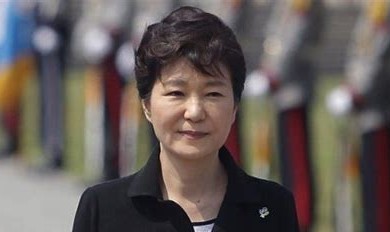
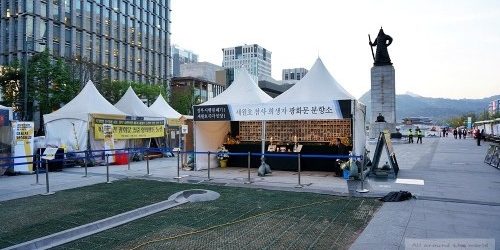
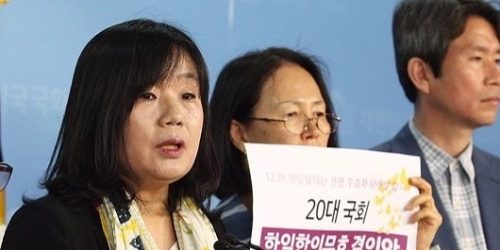
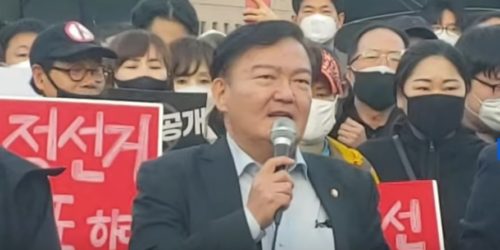


Great! I like it so much. God bless you!
Thank you very much for this valuable report. Your effort is of great help to understand the fact related to impeachment of innocent South Korea’s president.